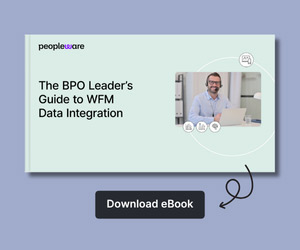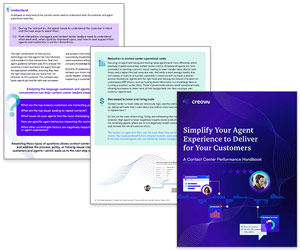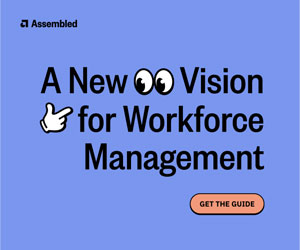Burnout has become a familiar word in the modern workplace, particularly in contact centres where pressure is often relentless.
But one specific and often overlooked contributor to this growing issue is scheduling-induced burnout.
To find out more we spoke to Doug Casterton, Workforce Optimisation Consultant at Right Time Right Place, to find out what scheduling-induced burnout is and what can be done to prevent it spiralling into a severe problem for both individuals and contact centres.
Video: How to Avoid Scheduling-Induced Burnout
Watch the video below to hear Doug explain scheduling-induced burnout in contact centres, and what can be done to tackle it:
With thanks to Doug Casterton, Workforce Optimisation Consultant at Right Time Right Place, for contributing to this video.
This video was originally published in our article ‘How to Prioritize Mental Health in the Contact Centre‘
What Is Scheduling-Induced Burnout?
Scheduling-induced burnout is a type of stress that builds up when shift patterns are poorly managed.
In contact centres, where agents often work to tight deadlines and changing schedules, this kind of burnout is surprisingly common.
It happens when people are regularly working hours that don’t give them enough time to rest or take care of things outside of work, as Doug explains:
“Scheduling-induced burnout is a significant component of the broader sort of burnout syndrome. It results directly from inappropriately, or poorly, managing your work schedules, that creates that chronic stress for agents.
Actually, there’s a definition from the World Health Organization as well, which is “a syndrome resulting from a chronic stress in the workplace that has not been successfully managed”, which from the context of the scheduling perspective is a primary contributor in contact centres.
And in fact I recently read, and I can’t quote you where it was from, that something like 35 to 40% of burnout issues are a result of scheduling issues, so it’s quite a significant thing in contact centres.”
It’s a key contributor to wider burnout issues and tends to creep in slowly, eventually affecting how people feel about their job and how well they can do it.
Because of the fast-paced and high-pressure nature of contact centres, how shifts are planned can have a big impact on both morale and performance.
What Causes Scheduling-Induced Burnout?
There isn’t just one thing that causes this kind of burnout, and it usually comes from a mix of scheduling issues that build up over time.
But there are a few common triggers:
Inconsistent or Disruptive Shifts
Shifts that run late into the night followed by early starts can mess with people’s sleep cycles and leave them feeling constantly tired.
Also split-shifts, where work is broken up into two chunks with a big gap in between, can also make it hard for agents to plan their day or get proper rest.
“Problematic scheduling patterns are often at the root of the issue, so things like back-to-back scheduling patterns – late nights followed by immediate early mornings – are a really big contributor.
They can disrupt the circadian rhythm as well, so it’s really very important to make it work. Split-shifts often fragment the day and make personal life planning nearly impossible.
And, by the way, some of the things I’m mentioning here, it’s not a one-size-fits-all thing – so for some people split-shifts actually can very good, but just generally speaking, they often can create stress from a shift scheduling perspective.”
Too Much Work, Not Enough Breaks
When agents are handling back-to-back calls without proper breaks, it becomes mentally and physically draining, and over time, this kind of pressure wears people down.
“Excessive workloads with high occupancy, when this leaves agents with barely any time to catch a breath between calls, can often cause that sort of burnout.”
Last-Minute Changes
Frequent, unexpected changes to shifts can throw off routines and make it hard for agents to plan their personal lives, and this kind of unpredictability adds another layer of stress.
“And then unpredictable last-minute changes in your schedules, so these can disrupt not only what you’re doing, but also impact personal commitments, and then create that chronic stress type scenario.”
No Say in the Schedule
If agents have no input into when they work, or if the system doesn’t consider their preferences or personal circumstances, it can lead to frustration and a sense of losing control over their own time.
“Another element I would say is lack of schedule control, so like when you implement a rigid scheduling system that doesn’t account for individual preferences or personal circumstances, I think this is another important point.
And also limited input into the actual creation themselves, similar to the preference, but this results in a profound lack of autonomy in their work–life balance preferences.”
Rigid Systems and Lack of Flexibility
Overly strict scheduling systems don’t leave much room to adapt, which can be a problem when agents need more flexibility, and can lead to feelings of being stuck in an inflexible routine that doesn’t work for them.
Over-Focus on Adherence
When the focus is only on sticking to exact shift times or targets, rather than outcomes or customer experience, it adds pressure.
Constantly being monitored can make agents feel more stressed, especially if they feel like they’re being judged on numbers instead of quality.
“I’d also say that micromanagement of adherence is in there as well, so sometimes this can also drive chronic stress and burnout-type situations because people are just seeking that number, rather than actually doing it for the right customer outcomes.”
The Knock-On Effects of Poor Scheduling
When scheduling goes wrong, it doesn’t just affect the people working the shifts – it affects the whole contact centre, but there will be differences, as Doug explained:
“Every contact centre will be slightly different because it depends upon your set-up, and how much of the scheduling is emphasizing, or how far along you are, say, in your in your reference-type scheduling, or work–life balance-type activities.”
The impact can be seen in performance, service levels, and even the bottom line. Here are a few signs to look out for:
Drop in Service Quality
Burnt-out agents may lose confidence and struggle to stay engaged. This can affect customer conversations, satisfaction scores, and how customers feel about the service overall.
“Typically, burnout decreases agents’ confidence in their job, so this is going to directly impact the quality metrics of your contact centre, whether that’s customer experience or NPS and such like that.”
Longer Calls and Higher Error Rates
Tired agents are more likely to make mistakes or take longer to solve issues, which not only frustrates customers but also leads to repeat calls and higher call volumes.
“Fatigue itself, which obviously is an outcome of burnout, can lead to higher average handle times, as agents struggle to focus or recall information because of that type of situation.
And also error rates as well may be linked to the quality side of things, as it could lead to more repeat calls, or customers’ frustrations, which then can lead on to that extra call volume.”
More Escalations
When agents don’t have the energy or headspace to fully resolve queries, issues are more likely to be escalated, which puts extra pressure on other teams and slows things down.
“And then I would say a last one, depending upon your business, you’re likely to experience higher escalation rates, because exhausted agents can lack the energy, or the patience, to fully resolve a contact, and therefore you’re likely to see that increase as well.”
Workload Spirals Out of Control
If burnout leads to performance dips, it often means more repeat contacts and unresolved issues.
In response, contact centres might push agents to work faster, which only adds to the pressure, and according to Doug:
“When in these types of situations, where you have potentially increased repeat rates, increased AHT, and increased escalations, you’re going to see more workload come in.
So the higher the amount of chronic stress, the more workload that’s created as a result of the failure demand, because of the things that weren’t done in the first place.
And you get into what I call this death spiral. What you end up doing is then going “okay, so how do we get ourselves back into a better service level position?”
So let’s work on maybe making our agents faster, which of course then has that effect of increased sickness, and all these sorts of things.
And I call it the death spiral of workforce planning because you could start with a fairly good service level, only because it’s being held up by agents that are basically being overworked, you’re going to see that descending spiral level, as you see those increased volumes, and AHT, and such like that.
And ultimately people will take breaks, so even if their occupancy is high, they’re going to need to take it eventually.”
This can lead to more sick days, more stress, and worse performance, which is a cycle that’s hard to break once it starts.
7 Ways to Prevent Scheduling-Induced Burnout
Scheduling-induced burnout is a real challenge in contact centres, but the good news is there are plenty of things contact centres can do to reduce the risk of burnout caused by poor scheduling.
By making smarter use of data, giving agents more say in their schedules, and building flexibility into planning, contact centres can protect their teams and improve performance at the same time.
To get you started, we’ve put together seven practical tips:
1. Spot the Risk Early With Data
Use workforce management tools to spot patterns that could lead to burnout – like frequent overtime, shift changes, or short rest periods.
You should look for signs like higher absence rates or drops in performance, as Doug explains:
“I always believe in data-driven wellness programmes wherever possible. So using workforce management analytics to identify those high-risk scheduling patterns, such as frequent changes, or insufficient rest periods, or excessive overtime, is one element that you can do.”
2. Set Clear Boundaries
Define what a healthy workload looks like. Set limits for overtime and make sure there’s enough rest between shifts, based on what’s worked well in the past.
“Establishing those clear thresholds for how you want to intensify your schedule and your rest periods based upon those historical data, and then tracking those wellness indicators such as increasing absence patterns, declining schedule adherence, or performance variability.
That proactively identifies those types of high-risk agents who might be either suffering burnout right now or are likely to suffer burnout in the future, because of the scheduling method that you’re currently deploying.”
3. Let Agents Pick Their Shifts
Offer self-scheduling options where agents can choose their own shifts within business needs.
“Increase your schedule transparency and control, so developing things and deploying things like self-service options that allow agents to self-select shifts within service level constraints.”
Giving people more control helps them feel more in charge of their work–life balance.
4. Make Shift-Swapping Simple
A good shift-swapping system lets agents trade shifts easily without affecting coverage. It adds flexibility while still keeping operations running smoothly.
“A shift-swapping platform is also really valuable as well, as it allows those agents to trade off shifts whilst they’re still maintaining the coverage requirements that you’ve got for your business.
5. Keep Agents in the Loop
Make sure schedules are communicated clearly and in advance, and even something as simple as timely notifications helps agents plan their lives better.
“Implementing schedule notifications – I think actually, believe it or not, such a simple thing but it can make a big difference, so agents know what they can expect when with their schedule and start to make the plans and personal commitments outside with confidence.”
6. Streamline Time-Off Requests
Make it easy for agents to see what’s available and request time off, as a simple, transparent process shows that their time and wellbeing are valued.
“Creating a streamlined time-off request system, I think if you haven’t already got that, that’s really important because that shows the real-time availability, and it makes it much easier for agents to self-select their holidays, and linked to the first one in the self-scheduling options.”
7. Design Schedules That Support Wellbeing
Build forward-rotating shifts (like moving from mornings to afternoons to evenings) that match the body’s natural rhythms.
Go beyond just the legal minimum for rest periods and think about what helps agents recover properly, as Doug continues:
“I think when it comes to designing wellness-centric schedules, I would say that you can create forward-rotating schedules, so the morning, afternoon, and night that align with the natural body rhythms – I think that’s important.
Implementing mandatory minimum rest periods – you’ve got to do that anyway from a labour law perspective, but design it specifically, not just what you have to do from a regulation perspective, but also what you want to provide to your people, because they’ll have a trade-off in terms of business optimization versus agent wellness optimization.
And I think that creating preferred schedule templates as well, so agents can select based upon their lifestyle needs, is also a really good step for a business to take.”
Offer schedule templates based on different lifestyles to give agents more personalized options.
Don’t Fall Prey to Cost Pressure
When budgets tighten, agent wellbeing often slips down the priority list, but sidelining it can be a costly mistake.
Burnout leads to higher sickness rates, lower productivity, and more customer issues, which in turn increase call volumes and staffing demands.
While it might seem efficient to push harder during tough times, ignoring the impact of poor scheduling can create a downward spiral that’s far more expensive to fix, as Doug concludes:
“I think we’ve come a long way in workforce management to really improve this area, but there’s still lots of opportunity.
And I still think that often when a business hits that cost pressure, this is the sort of thing that gets put to the side, and actually in fact it’s one of those metrics like I mentioned in that death spiral scenario that you actually do need to look after, and it has real impacts on your business outcomes.
So, putting it to the side when cost becomes a pressure is actually self-defeating, because you’re going to end up putting cost into your business as a result of not looking after the wellness of your agents.”
In the long run, investing in healthy scheduling practices isn’t just good for agents, it’s good for business, and ignoring wellbeing in the name of short-term savings can start a downward spiral that’s much harder (and more expensive) to fix later.
If you are looking for more great insights from the experts, check out these next:
- How to Break Bad Habits in Workforce Planning
- Reducing Abandoned Calls by Understanding Why
- How to Stay Ahead of Digital Customer Demand
- The Rise of Chatbots in Customer Service
Author: Robyn Coppell
Published On: 2nd Oct 2025 - Last modified: 3rd Oct 2025
Read more about - Video, Doug Casterton, Employee Engagement, Health Wellbeing and Stress, Scheduling, Shift Patterns, Videos, Workforce Management (WFM)










































